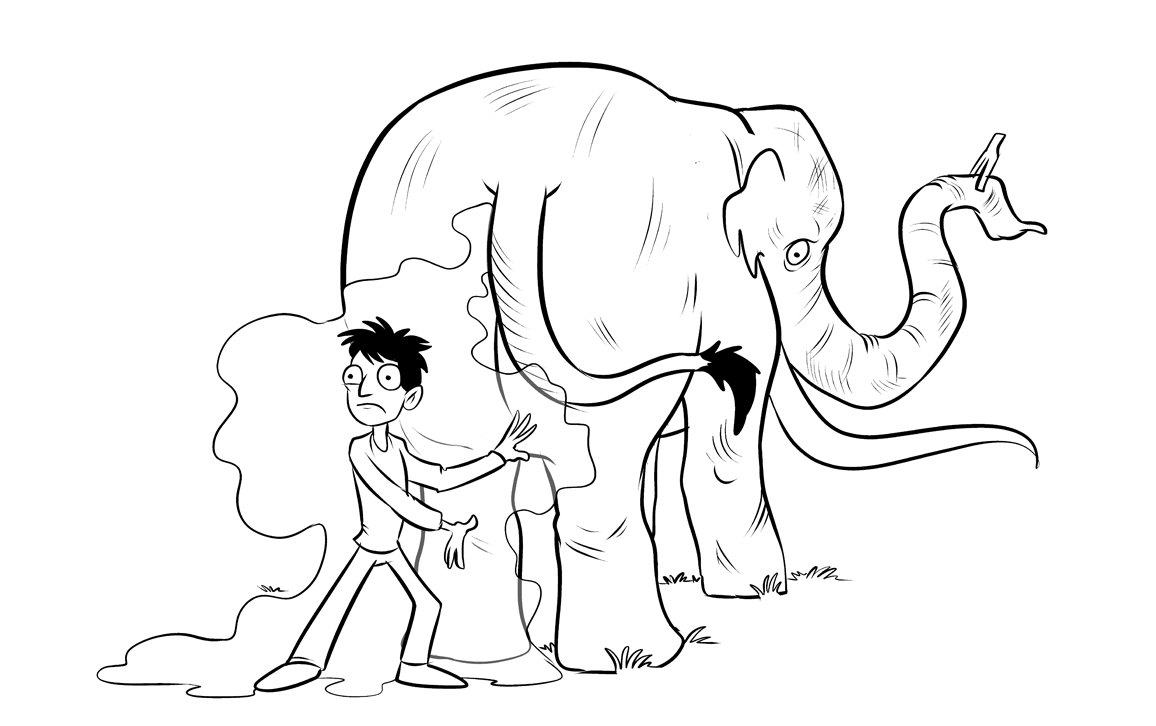Life's a Gas
By Katie L. Burke
Beyond its hilarity, flatulence reveals much about evolution and physiology.
Beyond its hilarity, flatulence reveals much about evolution and physiology.

Does It Fart? The Definitive Field Guide to Animal Flatulence. Nick Caruso and Dani Rabaiotti. Illustrated by Ethan Kocak. 144 pp. Hachette, 2018. $15.
“Do snakes!” my three-year-old nephew piped up. I scanned the book’s contents and flipped to page 65 to read about the eastern hognose snake.
“Does it fart?” I read aloud. “Probably.” The gaggle of kids sitting around the kitchen table squealed with laughter. I went on to share more details from the page in front of me, telling them that, like all snakes, this one probably farts and that it also has a defensive musk, which, although not technically a fart, is still stinky. Turning the page, I then told them about Sonoran coral snakes, which have an even more intriguing defense: They make a farting sound by sucking air into their cloaca (the opening through which they defecate and urinate). By contrast, the farts of pythons, we learned, while smelly, are “inaudible.”
Although adult readers are the target audience for Does It Fart? The Definitive Guide to Animal Flatulence, by biologists Nick Caruso and Dani Rabaiotti, I found kids of all ages to be keen on the subject matter. I had initially intrigued my nieces and nephew with the titular yes-or-no question by reading aloud nonchalantly about sharks (yes), goldfish (no), birds (no), and dinosaurs (not any more). Soon, I was swamped with requests about other animals from my curious onlookers. Even the kids’ parents started chiming in. For the little ones, I acted as science translator in some places, and prose abridger in others, to work around some of the tougher terms in the text.
For those who want more of the particulars, the authors readily oblige. A fart—properly termed flatulence in the scientific literature, they are quick to note—is gas, or flatus, produced during digestion, which is expelled through the anus. Caruso and Rabaiotti go into plenty of detail about the science behind farts of all kinds, explaining, for example, the hows and whys of the smelliest, the loudest, and the most silent (if not literally deadly), as well as discussing the functions farts serve and how different species deploy unique fart traits to their advantage.
It turns out that my nephew’s question was the same as the one that had initially inspired the book: A Twitter query about whether snakes fart prompted a lively discussion. The exchange made Caruso and Rabaiotti realize that they were not the only animal biologists to have uncovered people’s curiosity about farts, and that this realm of research is often shrouded in mystery and rife with hilarity. They crowdsourced much of the material in the book through Twitter, embarking in online discussions that ended up inspiring a deep collective research effort.

Illustrations (above and top) by Ethan Kocak, from Does It Fart?, Nick Caruso and Dani Rabaiotti, Hachette, 2018. Images courtesy of Kocak and the publisher.
The topic of flatulence is richer and more varied than readers might expect. Many of the particulars depend on an animal’s favorite foods, Caruso and Rabaiotti explain. High-protein diets cause especially stinky, sulfur-rich flatulence. Plant-rich diets generally require fart-producing microbes to digest cellulose, which is why cows and goats are notorious for their flatulence. The authors emphasize that some animals don’t fart at all: Some lack anuses, whereas others just don’t have the right diet or gut microbes.
Certain animals have proved especially difficult to study. For example, Caruso and Rabaiotti report that, although “whale farts are incredibly large,” they are also “remarkably elusive and have only been captured a handful of times on camera.” Furthermore, in the true spirit of science, the authors note that some creatures have merely not been observed farting, so researchers don’t know whether they do or not. That’s the case for both the bat and the spider: The jury’s still out. Scientists need to get cracking on that, although it’s understandable that no one has been quick to volunteer.
And then there are the flatulence anomalies. Herring use secret, high-frequency fart codes to communicate with one another without their predators listening in. Among insects, one species of beaded lacewing stuns and kills its prey by farting on it. Manatees have fart-storage pouches, because farts are so vital to their buoyancy “that constipated individuals cannot swim properly.”
Cheeky illustrations by Ethan Kocak add to the book’s general irreverence, as he depicts a range of animals at their gassiest. In one drawing, a wicked hippopotamus uses its tail to spread around its flatulence and feces. In another, a fartless bird displays an “Error 404 Fart Not Found” sign. A honey badger, in the style of the viral video from a few years back, clearly “don’t care” who it farts on. A bewildered elephant breaks wind while a very unfortunate human happens to be standing behind it.
On the day I was reading to my nieces and nephew, the book eventually had to be put away. But I glimpsed my 10-year-old niece sneaking a peek later to look up some of her remaining questions. The book now occupies a place of honor in my house, next to the toilet, where it is always on call to satisfy the curiosity of my lucky guests when they need a bit of bathroom reading.
Click "American Scientist" to access home page
American Scientist Comments and Discussion
To discuss our articles or comment on them, please share them and tag American Scientist on social media platforms. Here are links to our profiles on Twitter, Facebook, and LinkedIn.
If we re-share your post, we will moderate comments/discussion following our comments policy.